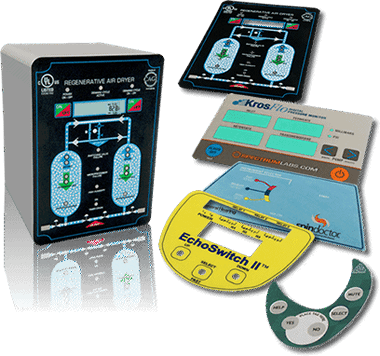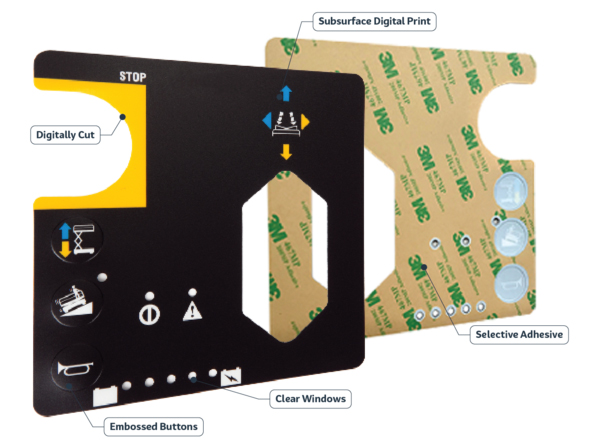How Shatterproof and Scratch-Resistant Graphic Overlays Enhance Durability
How Shatterproof and Scratch-Resistant Graphic Overlays Enhance Durability
Blog Article
Understanding How Graphic Overlays Work to Boost Your Creative Jobs
Graphic overlays function as an essential element in the world of imaginative projects, boosting both aesthetic interaction and audience engagement. By understanding their performance and possible applications, one can successfully raise not only the visual appeal but also the clarity of complex info. The effective integration of these overlays needs careful consideration of layout concepts and objectives. As we check out the various kinds and finest techniques, it comes to be obvious that the ideal strategy can considerably affect job outcomes, leaving us to consider just how to harness these tools for maximum influence.
What Are Graphic Overlays?
Graphic overlays are aesthetic components that are positioned on top of a base picture or user interface to enhance interaction and customer experience. They serve various purposes, including offering additional info, directing individual communication, and boosting aesthetic charm. Typical applications of visuals overlays can be located in electronic user interfaces, marketing, and educational products.

Graphic overlays are often created using layout software application, permitting developers to control size, openness, and shade to achieve the desired effect. Comprehending how to successfully apply graphic overlays is critical for developers aiming to elevate their creative projects.

Benefits of Making Use Of Graphic Overlays
Utilizing graphic overlays can significantly improve the performance of aesthetic interaction across numerous tools. One of the primary advantages is the capability to communicate complicated info succinctly. By layering graphics, message, and photos, overlays promote the discussion of data in a more absorbable format, making it much easier for target markets to comprehend crucial principles promptly.
Moreover, visuals overlays can enhance aesthetic charm, attracting interest to particular components within a style. This is especially helpful in marketing and advertising, where catching the visitor's rate of interest is critical. The tactical usage of shades, shapes, and typography in overlays can produce a natural and engaging aesthetic story, improving brand name acknowledgment.
Furthermore, visuals overlays give flexibility in layout. They enable creators to adapt material for various platforms without going back to square one, ensuring consistency across various networks. This flexibility is important in today's digital landscape, where material should be maximized for diverse gadgets and styles.
Kinds Of Graphic Overlays
When thinking about the numerous kinds of graphic overlays, it is important to acknowledge their varied applications across various sectors. Graphic overlays can be classified primarily into three kinds: useful, decorative, and informative.
Useful overlays are made to enhance the usability of an item. Typically located in digital tools, these overlays usually provide tactile responses through elevated buttons or distinctive surfaces, improving individual interaction. They can additionally act as a safety layer, safeguarding the underlying parts from deterioration.
Decorative overlays concentrate on visual enhancement, permitting brand names to reveal their identification through vivid designs and customized graphics. These overlays are widespread in product packaging, advertising and marketing, and point-of-sale products, where visual appeal is essential for attracting customers.
Educational overlays, on the various other hand, are used to convey important information or directions. They can be seen in applications such as signs, user handbooks, and training graphics, where clarity and readability are extremely important.
Each type of graphic overlay serves an one-of-a-kind purpose, adding to the general performance of innovative tasks while dealing with specific requirements within various sectors. Understanding these distinctions is crucial for choosing the best overlay for your job.
Best Practices for Implementation
To ensure the effective implementation of visuals overlays, it is important to establish a clear understanding of the project's objectives and the details requirements of the end-users. Begin by conducting complete research to identify the target audience and their preferences, as this will notify design selections and functionality.
Following, develop a comprehensive strategy that outlines the overlay's integration, function, and design process. This plan must include customer interface considerations, making certain that overlays boost instead than obstruct the individual experience - Graphic Overlays. Take into consideration the aesthetic pecking order and maintain uniformity in layout components, such as color font styles, schemes, and icons, to promote brand name comprehensibility
Examining pop over to this site is important; collect responses from a depictive example of customers to recognize prospective problems and areas for improvement. Iterate on the design based upon user input and performance information. In addition, make sure compatibility across numerous tools and systems to make the most of ease of access.
Devices for Producing Overlays
Developing effective graphic overlays requires the right tools to equate design ideas right into functional applications. Various software program and platforms are offered, each customized to certain requirements and skill levels.
Adobe Photoshop and Illustrator are industry criteria, supplying considerable capabilities for creating and manipulating overlays. These devices supply sophisticated attributes such as layer administration, mixing settings, and vector graphics, enabling developers to develop premium and detailed view it overlays.
For those seeking a much more easy to use technique, Canva and Figma are outstanding alternatives (Graphic Overlays). Canva's instinctive user interface enables individuals to produce overlays quickly using pre-designed templates, while Figma assists in collaborative layout in real-time, making it ideal for groups
In addition, open-source options like GIMP and Inkscape give robust functionalities without the associated prices of exclusive software application. These devices permit adaptability in style and can accommodate numerous data layouts, guaranteeing compatibility across different systems.

Verdict
To conclude, graphic overlays function as effective devices for enhancing creative tasks by offering aesthetic quality, aesthetic appeal, and brand uniformity. Their diverse applications, varying from practical to ornamental, highlight their flexibility in interaction. Abiding by finest methods and utilizing ideal devices guarantees effective implementation and makes best use of the effect of overlays. By recognizing the essential principles and additional hints advantages linked with visuals overlays, developers can dramatically boost the high quality and effectiveness of their aesthetic communications.
Graphic overlays serve as an essential element in the realm of creative jobs, improving both aesthetic communication and audience engagement.Graphic overlays are frequently developed making use of design software, permitting developers to control openness, size, and shade to accomplish the desired effect.Moreover, visuals overlays can enhance visual charm, attracting interest to particular components within a style.Additionally, graphic overlays supply flexibility in design.In verdict, visuals overlays serve as effective tools for enhancing innovative projects by offering visual clearness, visual charm, and brand uniformity.
Report this page